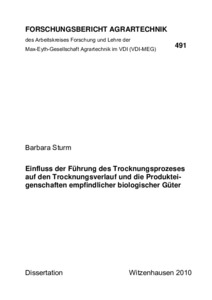| dc.date.accessioned | 2010-10-25T12:11:10Z | |
| dc.date.available | 2010-10-25T12:11:10Z | |
| dc.date.issued | 2010-10-12 | |
| dc.identifier.issn | 0931-6264 | |
| dc.identifier.uri | urn:nbn:de:hebis:34-2010102534814 | |
| dc.identifier.uri | http://hdl.handle.net/123456789/2010102534814 | |
| dc.language.iso | ger | |
| dc.rights | Urheberrechtlich geschützt | |
| dc.rights.uri | https://rightsstatements.org/page/InC/1.0/ | |
| dc.subject | Trocknungstechnik | ger |
| dc.subject | Produktqualitaet | ger |
| dc.subject | DoE | ger |
| dc.subject.ddc | 620 | |
| dc.title | Einfluss der Führung des Trocknungsprozesses auf den Trocknungsverlauf und die Produkteigenschaften empfindlicher biologischer Güter | ger |
| dc.type | Dissertation | |
| dcterms.abstract | Die Konvektionstrocknung ist eine der ältesten Methoden zur Konservierung von Lebensmitteln. Es ist bekannt, dass Agrarprodukte temperaturempfindlich sind. Bei Überhitzung erleiden sie chemische und physikalische Veränderungen, die ihre Qualität vermindern. In der industriellen Praxis wird die Konvektionstrocknung in der Regel auf Grundlage empirisch ermittelter Werte durchgeführt, welche die Produkttemperatur nicht berücksichtigen. Es ist deshalb nicht sichergestellt, ob der Prozess optimal oder auch nur gut betrieben wird.
Inhalt dieser Arbeit ist ein Vergleich der klassischen einstufigen Konvektionstrocknung mit einer Prozessführungsstrategie bei der die Produkttemperatur als Regelgröße eingeführt wird. Anhand der Untersuchung des Trocknungsverhaltens von Äpfeln werden die beiden Verfahren analysiert, die erhaltenen Ergebnisse miteinander verglichen und daraus optimierte Trocknungsbedingungen abgeleitet.
Die für dieses Projekt entwickelte Prozessanlage erlaubt die simultane Untersuchung sämtlicher wesentlicher Temperaturen, der Gewichtsveränderung und der optischen Qualitätskriterien. Gleichzeitig ist es möglich, entweder die Lufttemperatur oder die Temperatur des Produktes zur regeln, während die jeweils andere Größe als Messwert erfasst wird. Es kann weiterhin zwischen Durch- und Überströmung gewählt werden. | ger |
| dcterms.abstract | Drying is one of the oldest and most important means of preserving food. Particularly in the field of agricultural products, which are produced in large quantities and of which processing adds a low net value, convective drying is of great importance.
Most biological products are heat sensitive and are additionally damaged by extended drying time. Concurrently, duration of drying depends strongly on the temperature level used. Therefore it is necessary to make sure that the product does not exceed critical temperatures during the drying process. Meanwhile it is well known that sensitive products may be exposed to high air temperatures during the first stage of drying without risking any damage. The functional relation between duration of impinging with certain conditions of the drying medium (temperature, humidity, and velocity), development of product temperature and changes the product undergoes during the process are scarcely researched.
Two different kinds of process control for convection drying of sensitive biological products were investigated and the results compared. The first strategy was a onestep drying process with constant air temperature throughout, whereas the second strategy used the product temperature to control the process. After a short warm up phase product temperature was kept constant during the rest of the process.
The aim of the work presented was the continuous measurement of previously chosen physical values and to predict interactions between type and duration of certain process settings and the changes that chosen quality aspects underwent. Based on those results, the optimisation of drying conditions has to be performed. Secondly results for both strategies should be compared and their influences on the quality aspects should be analysed.
To cover a large parameter space of the chosen factors (temperature, air velocity and dew point temperature) and to secure the results statistically planning, modelling and optimisation were utilised using a commercial programme (design of experiments). Additionally, interactions between factors could be analysed and optimisation with variable target values is possible.
The laboratory drier developed for this project allows the simultaneous non invasive measurement of all essential temperatures, change of weight and optical quality criteria based on digital images. At the same time air or product temperature can be controlled while the other value is measured. It is possible to select between through flow and over flow. When controlling product temperature, air velocity in the drier is kept constant. Ventilation performance is readjusted depending on the difference between drying air and ambient temperature. Hence, the thermal expansion of the air is compensated. | eng |
| dcterms.accessRights | open access | |
| dcterms.alternative | Influence of Process Control on Drying Kinetics and Product Attributes of Sensitive Biological Products | eng |
| dcterms.creator | Sturm, Barbara | |
| dcterms.isPartOf | Forschungsbericht Agrartechnik des Fachausschusses Forschung und Lehre der Max-Eyth-Gesellschaft Agrartechnik im VDI (VDI-MEG) ;; 491 | ger |
| dc.contributor.corporatename | Kassel, Universität, FB 11, Ökologische Agrarwissenschaften | |
| dc.contributor.referee | Hensel, Oliver (Prof. Dr. sc. agr.) | |
| dc.contributor.referee | Hofacker, Werner (Prof. Dr.-Ing.) | |
| dc.subject.swd | Trocknung | ger |
| dc.subject.swd | Prozessregelung | ger |
| dc.subject.swd | Qualität | ger |
| dcterms.source.series | Forschungsbericht Agrartechnik des Fachausschusses Forschung und Lehre der Max-Eyth-Gesellschaft Agrartechnik im VDI (VDI-MEG) | ger |
| dcterms.source.volume | 491 | ger |
| dc.date.examination | 2010-06-09 | |

